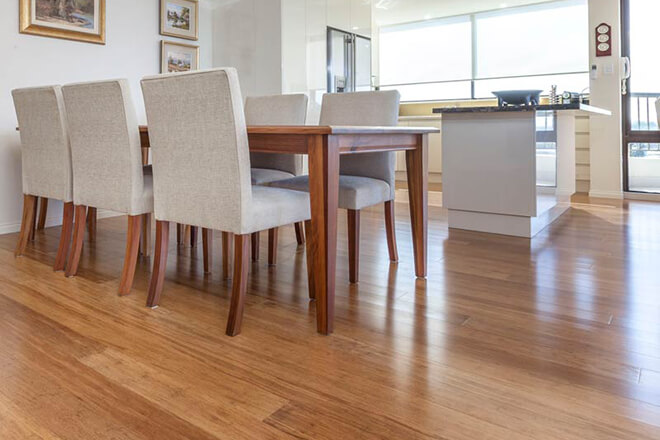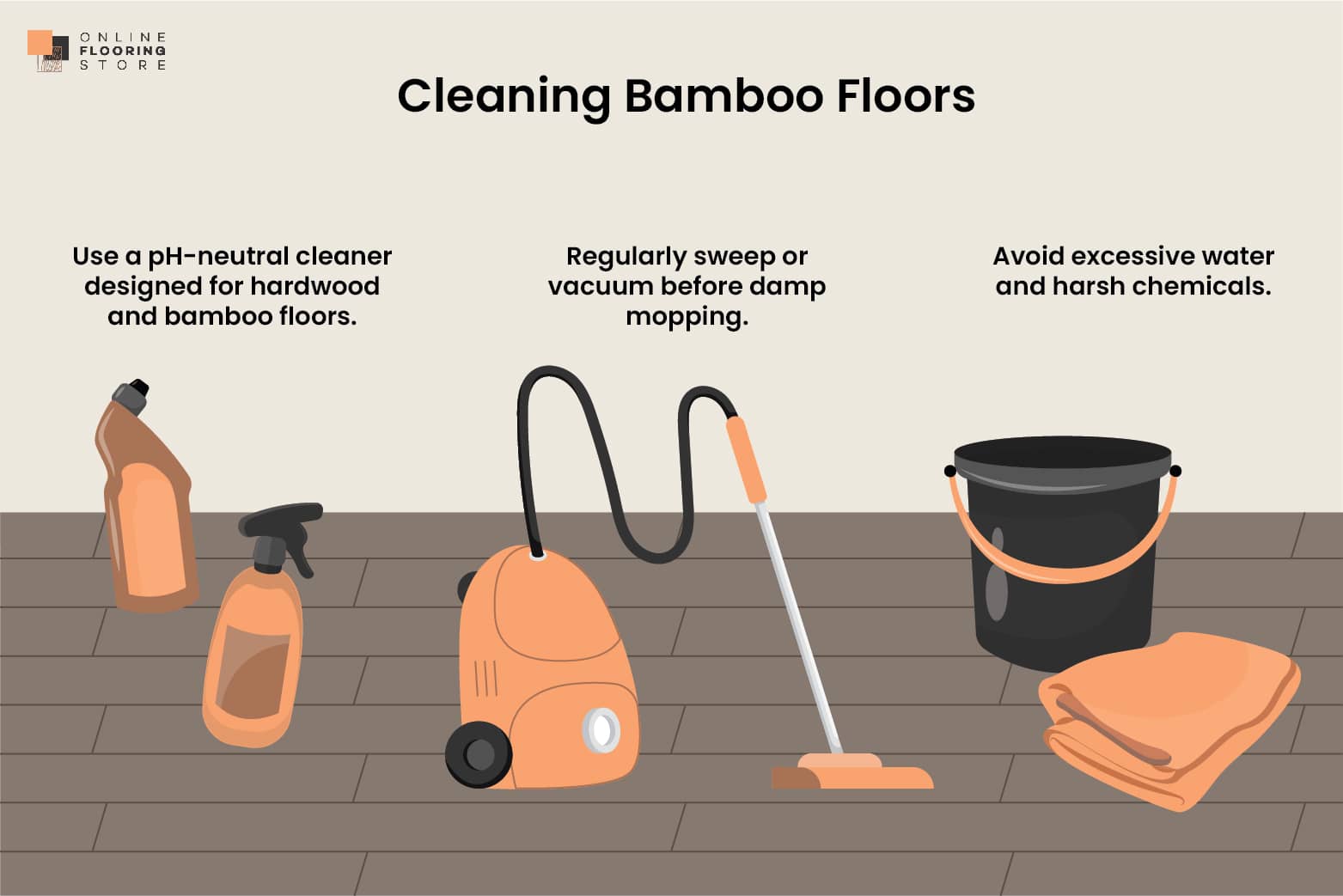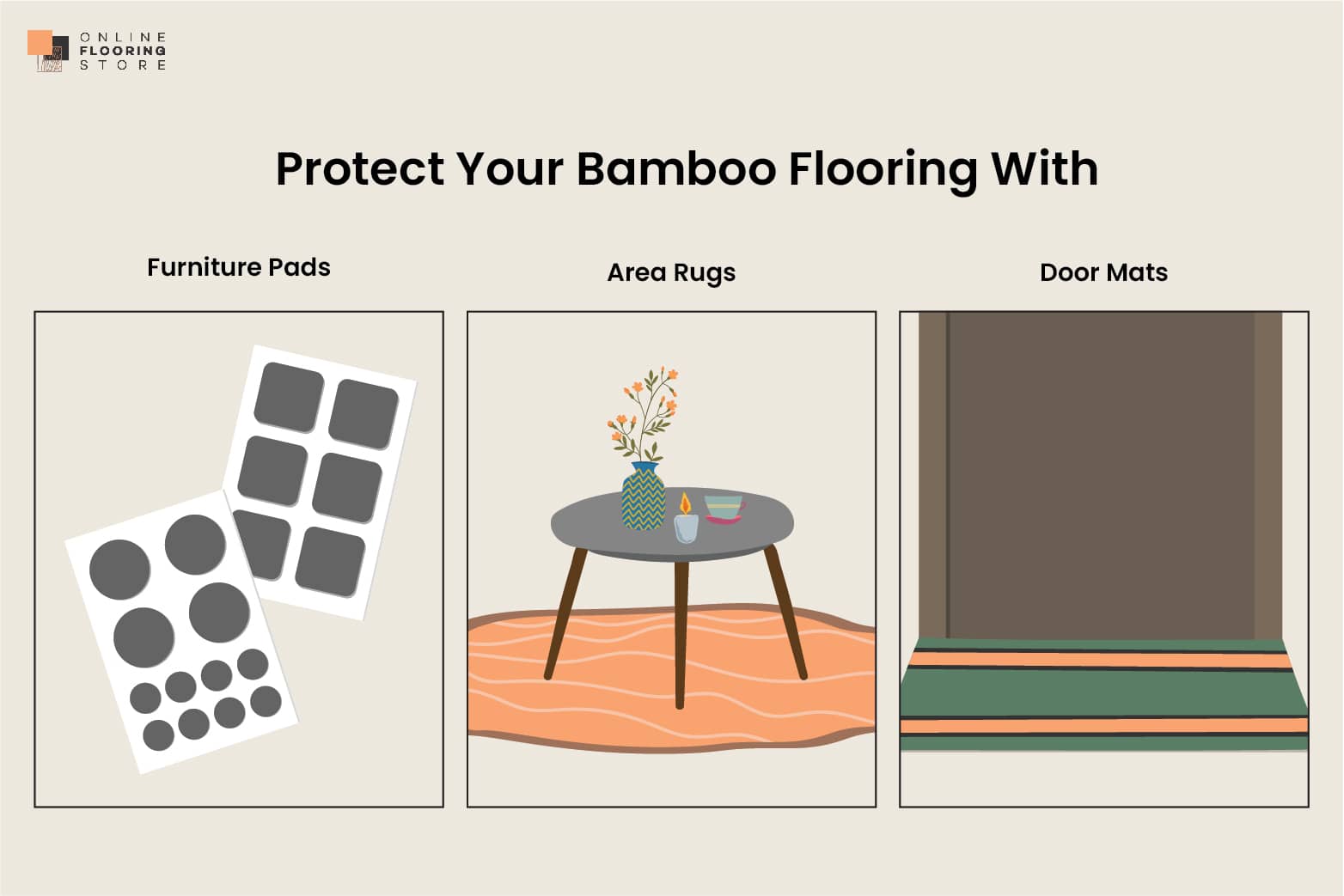Bamboo flooring’s durability, eco-friendliness, and stunning appearance make it a top choice for many Australian homeowners. As a proud owner of bamboo floors in my home, I’ve learned that proper cleaning and maintenance are crucial to preserving beauty and longevity.
Cleaning bamboo floors doesn’t have to be complicated or time-consuming. With the proper techniques and products, you can keep your bamboo flooring pristine. I’ve discovered that regular sweeping or vacuuming, followed by damp mopping with a suitable bamboo floor cleaner, is the most effective routine for maintaining these beautiful floors.
In this guide, I’ll share my expert tips on how to clean bamboo flooring effectively, including the best cleaners to use and techniques to avoid. Whether dealing with everyday dust and dirt or tackling tougher stains, I’ve covered you with practical advice to keep your bamboo floors in top condition.
Key Takeaways:
- Use a pH-neutral cleaner designed for hardwood and bamboo floors
- Regularly sweep or vacuum before damp mopping for best results
- Avoid excessive water and harsh chemicals to protect your bamboo flooring
Understanding Bamboo Floors
Bamboo flooring offers a unique blend of style and sustainability. It’s an excellent alternative to traditional hardwood, with several distinct advantages.
Types of Bamboo Flooring
Bamboo floors come in various styles to suit different preferences:
- Vertical bamboo flooring features strips placed vertically, creating a uniform look. Horizontal bamboo showcases the bamboo’s natural knuckles.
- Solid bamboo is made entirely from bamboo fibres, offering durability comparable to hardwood. Engineered bamboo flooring consists of a bamboo veneer atop a plywood or fiberboard core, providing enhanced stability.
- Strand-woven bamboo is the toughest option, created by compressing bamboo fibers under high pressure. This type rivals the hardness of many traditional hardwoods.
Benefits of Bamboo Flooring
- I’ve noticed that bamboo flooring is cost-effective compared to many hardwood options.
- It’s also environmentally friendly, as bamboo grows much faster than trees used for timber flooring.
- Bamboo floors are known for their durability and resistance to wear.
- They’re less prone to expansion and contraction than traditional hardwoods, making them suitable for various climates.
These floors offer a unique aesthetic, ranging from light natural tones to darker carbonized shades. They can complement a wide array of interior design styles. To learn more about Bamboo flooring, we recommend reading this article on its pros and cons.
With proper care, bamboo floors can maintain their beauty for many years.
Essential Bamboo Floor Cleaning Tips
Keeping bamboo floors clean requires routine maintenance and quick action when spills occur. I’ll share my top strategies for maintaining the beauty and longevity of your bamboo flooring.
Maintenance is relatively simple, requiring regular sweeping and occasional damp mopping. With proper care, bamboo floors can maintain their beauty for many years.
Routine Cleaning and Maintenace Strategies
- I always start by removing dust and dirt daily using a soft-bristle broom or vacuum with a hard floor attachment. This prevents scratches from abrasive particles.
- For deeper cleaning, I use a damp mop weekly. I ensure the mop is slightly damp, as excess water can damage bamboo. I work in small sections, using a back-and-forth motion along the wood grain.
- The best way to clean bamboo floors is to use a gentle, pH-neutral cleaner designed for hardwood surfaces.
- After mopping, I dry the floor with a soft cloth to prevent water damage.
Dealing with Spills and Stains
- When spills happen, I act fast. I immediately wipe liquids with a clean, dry cloth to prevent staining and water damage.
- For stubborn stains, I use a slightly damp cloth with a pH-neutral cleaner designed for bamboo floors. I gently rub the area in a circular motion, and I always dry the area immediately after cleaning.
- Oil-based stains can be tricky. I sprinkle a small amount of baking soda on the spot, let it sit for a few minutes, then wipe it away with a damp cloth.
- I use a tennis ball to gently buff them out for tough marks like scuffs. It’s surprisingly effective!
Choosing the Right Bamboo Floor Cleaner
Selecting an appropriate cleaner is crucial for maintaining bamboo flooring. I’ll cover commercial and DIY options and what to avoid to keep your floors in top condition.
Commercial vs DIY Cleaners
- For commercial cleaners, I recommend pH-neutral products designed explicitly for bamboo floors. Bona Hardwood Floor Cleaner is a top choice, as it’s safe and effective. These cleaners are convenient and formulated to protect the floor’s finish.
- DIY solutions can be equally effective. If you don’t have the hardwood floor cleaner, My go-to cleaning solution is a mixture of warm water and a few drops of mild dish soap. No, it is not a fancy floor cleaner, but it works well and is cost-effective. The main thing is avoiding harsh chemicals that strip the floor’s finish. Mix 1/4 cup of mild dish soap with 3.5 litres of warm water for a simple, cost-effective cleaner.
Consider your floor’s specific needs and personal preferences when choosing between commercial and DIY. Commercial products may offer specialized benefits, while DIY solutions allow you to control the ingredients.
What to Avoid
- I strongly advise against using harsh chemicals or abrasive cleaners on bamboo floors. Steam mops are a big no-no, as the excess moisture and heat can damage the flooring.
- Avoid wax-based cleaners, which can leave a residue and dull the floor’s finish. Oil-based products are also problematic, making the surface slippery and attracting dirt.
- Ammonia and vinegar-based cleaners should not be used. While vinegar and water are affordable and eco-friendly cleaning solutions for many household surfaces, they are unsuitable for wood floors. Using this mixture on wood flooring can damage the surface, making it unfit for maintaining your bamboo floors.
- Steer clear of any cleaner that promises to “shine” or “polish” your bamboo floor. These often contain ingredients that can build up and make future cleaning more difficult.

Expert Insights From Levi Saunders
Online Retail Specialist & Flooring Content Creator
As a consumer, you may find it hard to find a floor cleaner that claims to be specifically tailored to bamboo floors. Or at least I have!
Protecting Your Bamboo Floors
Proper protection and maintenance are crucial for beautifying your bamboo flooring for years. I’ll share some key strategies to safeguard your investment.
Use Furniture Pads and Area Rugs
Furniture pads are essential for protecting bamboo floors from scratches and dents.
- I recommend using felt pads under the legs of chairs, tables, and other heavy furniture. These inexpensive protectors can prevent significant damage.
- For frequently moved items like dining chairs, I suggest checking the pads regularly and replacing them as needed. Rubber or plastic pads can sometimes leave marks on bamboo, so felt is often the best choice.
- Consider using area rugs in high-traffic zones or under rolling office chairs. This extra layer of protection can significantly reduce wear and tear on your bamboo flooring.
- I also recommend placing doormats at entrances to trap dirt before it reaches your bamboo floors. This simple step can significantly reduce the abrasive particles that come into contact with your flooring.
Choosing Your Tools
Choosing the right tools and employing effective techniques are crucial for maintaining bamboo flooring.
- To clean bamboo floors effectively, I recommend using a microfiber dust mop as a primary tool. It’s gentle yet efficient at picking up dust and debris without scratching the surface. For deeper cleaning, a damp mop with a microfiber pad works well.
- I also suggest having a soft-bristled broom and a vacuum with a soft brush attachment for routine cleaning. These tools help remove dirt and grit that can scratch the floor over time.
- A spray bottle filled with a mild cleaning solution and a soft cloth are indispensable for spot cleaning. Avoid abrasive tools or steam mops, which can damage the bamboo’s finish.
Frequently Asked Questions
Maintaining bamboo flooring requires specific care and cleaning techniques. The following questions address common concerns about keeping bamboo floors in top condition.
I recommend sweeping or vacuuming daily to remove dirt and debris. Use a soft-bristled broom or vacuum with a soft brush attachment. Mop weekly with a damp microfiber mop and a mild bamboo or hardwood floor cleaner. Avoid excessive water and wipe up spills immediately.
Place mats at entryways to trap dirt. Use felt pads under furniture legs to prevent scratches. Maintain consistent indoor humidity between 35-55% to prevent warping.
Yes, excess water can damage bamboo flooring. I advise against using wet mops or steam cleaners. Instead, use a slightly damp mop and avoid leaving standing water on the floor.
Water-resistant bamboo flooring offers better protection, but all bamboo floors can be damaged by prolonged exposure to moisture.
I suggest using a pH-neutral cleaner designed explicitly for bamboo or hardwood floors. Avoid harsh chemicals, oil-based products, or abrasive cleaners.
Some excellent options include Bona Hardwood Floor Cleaner, Pallmann Clean, and Rock Doctor's Bamboo Cleaner. Always follow the manufacturer's instructions for best results.
I recommend daily sweeping or vacuuming to remove loose dirt and debris. For routine cleaning, damp mop with a bamboo floor cleaner once a week.
Deep clean your bamboo floors every 2-3 months, depending on foot traffic and wear. Adjust the frequency based on your household's needs.
I suggest using a slightly damp cloth with a small amount of bamboo floor cleaner for stubborn stains. Gently rub the stain in a circular motion.
For tougher stains, create a paste using baking soda and water. Apply it to the stain, let it sit briefly, and then wipe it clean with a damp cloth. Always test in an inconspicuous area first.
I do not recommend steam-cleaning bamboo floors. The heat and moisture from steam cleaners can damage the bamboo, causing it to warp, swell, or crack.
For the best results and longevity of your floors, stick to dry cleaning methods like sweeping and vacuuming, followed by damp mopping with a bamboo-specific cleaner.






